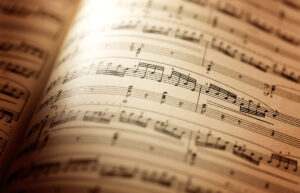The Complete Guide on What Is a Refrain In Music

This guide encompasses all information about refrains used in music. We define a refrain in the musical context and details its origin and existence in the musical scene. Furthermore, we detail why refrains are used in music and their key characteristics. We provide a glimpse of how to incorporate a refrain in music and elaborate how it works in popular music. We distinguish the difference between refrain and chorus for a better understanding of the refrain and present examples of refrain in music to illustrate its usage.
Welcome to TheDemoStop, now join the community!
Connect with artists, fans and producers around the world.
What is a refrain in music?
A refrain in music is a section of a song that recurs multiple times. It’s a part of the song that’s repeated with the same melody, lyrics, phrases or all three. Refrains often contain the central theme or message of the song, making them memorable and easier for listeners to connect with. They can be catchy and serve as a structural anchor within the composition, contributing to the overall cohesion and impact of the music.
History of refrains in music
The use of refrains in music dates back centuries and can be found in ancient cultures such as Greek poetry as well as medieval European music. In these compositions, refrains were repeated sections or phrases that provided structure and helped to reinforce the primary theme of a composition. Over time, refrains evolved and became a common element in various musical forms, including folk songs, hymns, and eventually in contemporary popular music.
Why are refrains used in music?
Refrains play a crucial role in music by providing a recurring point of reference within a song. They serve as musical landmarks, guiding listeners through the piece and providing a recognizable, memorable section that often contains the core message or emotion of the song. This repetition helps to solidify the song’s structure, making it more accessible and engaging for the audience. Refrains create a sense of unity, tying various sections of the music, and their repetitive nature often makes them the most memorable parts of a song, leaving a lasting impression on the listener.
Moreover, refrains often encapsulate the essence of the song, containing the primary message or emotional core. By repeating this central theme, refrains emphasize and reinforce the song’s purpose, making it easier for the audience to connect with and remember.
Characteristics of refrains
Lines
Refrains consist of lines or phrases within a song that are repeated at specific intervals. These lines often contain the central theme, the catchiest melody, or the most memorable lyrics in the composition. The repetition of these lines throughout the song creates familiarity and serves as an anchor, rendering it easier for listeners to connect with and remember the song.
Intervals
Refrains appear at regular intervals within a song’s structure. They typically follow each verse or bridge and recur consistently throughout the piece. These intervals establish a predictable pattern that enhances the song’s structure, allowing listeners to anticipate and engage with the repeated refrain each time it appears.
Repetition of lyrics or melody
A characteristic of a refrain is the repetition of specific lyrics, melodies, or both. This repetition occurs at regular intervals within the song, providing a familiar and recurring section that listeners can easily recognize. The consistent repetition of these elements reinforces the central theme or message of the song.
Catchy and memorable
Refrains are often designed to be catchy and memorable. They contain a distinctive melody, rhythm, or lyrics that stand out within the song. Because they are catchy, it makes them easily memorable for listeners, encouraging sing-alongs and leaving a lasting impression after the song has ended.
Often the title of the song
In many cases, the refrain contains the title of the song. This makes the title a central and repeated element within this composition, reinforcing its significance and making it more prominent in the listener’s mind. It ties the main theme of the song directly to its title, reinforcing the song’s identity.
Welcome to TheDemoStop, now join the community!
Connect with artists, fans and producers around the world.
How to write refrain in music
Start with a strong hook
Begin the refrain with a powerful and captivating musical phrase or lyric that grabs the listener’s attention. This initial “hook” sets the tone for the entire refrain and makes it memorable.
Keep it simple and easy to remember
Refrains should be straightforward and uncomplicated. Use simple and easily understandable lyrics or melodies to ensure that listeners can quickly grasp and remember them.
Lyrics
Craft lyrics that encapsulate the message or theme of the song. The words used in the refrain should be concise, impactful, and reflective of the song’s overall narrative or emotion.
Melody
Create a catchy and distinctive melody for the refrain. A strong and memorable tune will make the refrain stand out and linger in the listener’s mind.
Use repetition effectively
Repetition is key in a refrain. Repeat the chosen lyrics and melody at regular intervals throughout the song to reinforce the refrain’s importance, making it more recognizable and easier for listeners to connect with.
How does the refrain work in popular music?
In popular music, the refrain serves as the fundamental component, often taking the form of a catchy chorus that repeats multiple times throughout the song. This chorus typically contains the song’s title or a central message, making it memorable and easy for listeners to sing along. The refrain in popular music functions as a focal point, emphasizing the main theme or emotion of the song. A refrain often follows verses, which advances the narrative or story, providing a contrast and highlighting the central message when it returns. This repetition solidifies the song’s structure and creates a sense of familiarity, contributing to its commercial success by making it more accessible and engaging for a wide audience.
Examples of refrains in popular music
“Don’t Stop Believin’” by Journey
The refrain in this song is the iconic line “Don’t stop believin.” It serves as the catchy and powerful chorus that repeats throughout the song. The simple yet uplifting message of perseverance and hope is reinforced by the repetition of this memorable phrase, making it a standout element of the song.
“I Will Always Love You” by Whitney Houston
In this song, the refrain includes the poignant line “And I will always love you.” This refrain, repeated multiple times, encapsulates the emotional core of the song. Whitney Houston’s powerful delivery of these lyrics in the chorus makes it one of the most memorable parts of the song, conveying deep emotion and leaving a lasting impact on listeners.
“Hey Jude” by The Beatles
The refrain in “Hey Jude” includes the repeated lines “Hey Jude, don’t make it bad. Take a sad song and make it better.” This refrain is not only catchy but also serves as a comforting and supportive message throughout the song. The repetition of these lines reinforces the song’s empathetic and encouraging tone, making it a memorable and singable part of the track.
Difference between refrain and chorus
The distinction between a refrain and a chorus lies in their roles within a song. A refrain refers to a repeated line or phrase that recurs at intervals, often following verses, and it can be catchy and recurring. On the other hand, a chorus is a specific segment that repeats after each verse and typically embodies the song’s main message, featuring more consistency in its melody, lyrics, and thematic significance. The chorus tends to be the emotional and lyrical climax of the song, carrying more weight in terms of memorability and impact, while the refrain might offer varied content and may or may not align directly with the song’s primary theme or title.
Conclusion
What is a refrain in music?
A refrain in music is a repeated section of a song, often a chorus or a similar musical passage that recurs multiple times throughout the piece. It usually contains the main theme or message of the song and is often catchy and memorable to listeners.
History of refrain in music: The use of refrain in music dates back centuries and can be found in ancient cultures such as Greek poetry and in medieval European music. Refrains were repeated sections or phrases that provided structure, reinforced the main theme, and helped in storytelling. Over time, refrains evolved and became common elements in various musical forms, including folk songs, hymns, and eventually in contemporary music.
Welcome to TheDemoStop, now join the community!
Connect with artists, fans and producers around the world.
Importance of refrain in music: Refrain is important in music as it provides structure, repetition, and a memorable element that reinforces the central theme or message of a song. They make music more accessible, engaging, and easier for listeners to connect with. Refrains are used in music to create structure, repetition, and emphasis, anchoring the song’s main theme or message. They make the song memorable, engaging, and more relatable for listeners.
Characteristics of refrain:
- Lines
- Interval
- Repetition of lyrics or melody
- Catchy and memorable
- Often the title of the song
How to write refrain in music
- Start with a strong book
- Keep it simple and easy to remember
- Lyrics
- Melody
- Use repetition effectively
How does the refrain work in the popular music genre? In popular music, the refrain typically functions as a catchy and memorable chorus that repeats throughout the song. It often contains the song’s title or main message, emphasizing its central theme. The repetition of the refrain enhances the song’s structure, making it more memorable and accessible to a wide audience.
Examples of refrain in popular music
- “Don’t Stop Believin” by Journey
- “I Will Always Love You” by Whitney Houston
- “Hey Jude” by The Beatles
Difference between refrain and chorus: The refrain and the chorus in music are often used interchangeably, but the chorus is more musically and lyrically consistent throughout, while the refrain might vary in content. All refrains can be choruses, but not all choruses are refrains.
FAQs
What is a musical refrain called?
A refrain is a line or verse that is repeated frequently in a song, often accompanied by a melody that is unique to that line or verse.
What is the purpose of refrain in a song?
The purpose of refrain in a song is to provide a repeated section that reinforces the main theme or message, adds structure, and enhances memorability for listeners.
Why are refrains made in music?
Refrains are created in music to offer repetition, structure, and emphasis, reinforcing the central theme or message of a song and making it more memorable for listeners.
What part of a song is the refrain?
The refrain is a repeated section of a song that typically contains the main theme or message.
Are refrains always the same in a song?
No, refrains in a song are often similar or identical when they repeat but may have variations in lyrics, melody, or musical arrangement in some cases.
How do refrains contribute to the overall structure of a song?
Refrains contribute to the structure of a song by providing a recurring section that anchors the main theme, adds coherence, and enhances the song’s memorability and listener engagement.
How many lines does a refrain have?
A refrain can vary in length, but typically it consists of a few lines or phrases that are repeated at specific intervals within a song.
What feelings do the refrains create?
Refrains in music can evoke familiarity, emphasis, and reinforcement of the song’s emotions, themes, or messages. They often create a sense of connection and engagement with the listener.
Are refrains used in all types of music?
Yes, refrains are a common element found in various genres and types of music, although their specific structure and usage varies across different musical styles.
How do songwriters create effective refrains?
Songwriters create effective refrains by crafting catchy melodies, simple and memorable lyrics, repeating the central theme, ensuring the refrain aligns with the song’s emotion, and utilizing rhythmic or melodic hooks to make it stand out.
What are some famous songs with memorable refrains?
- “Don’t Stop Believin’” by Journey
- “I Will Always Love You” by Whitney Houston
- “Hey Jude” by The Beatles































































